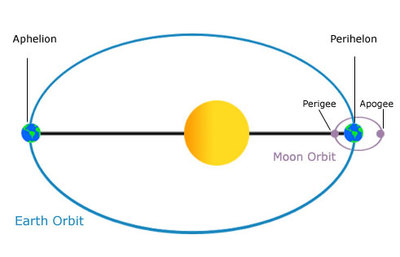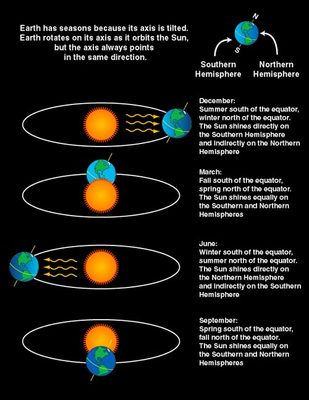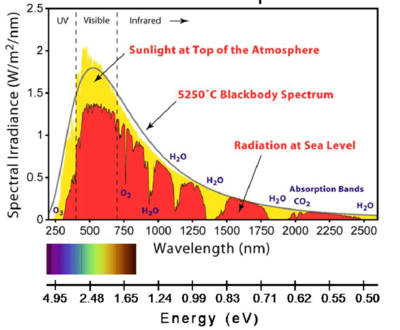Earth/Sun Relationship
Earth's Annual Orbit of Sun
The Earth orbits the sun once a year. Were there significant changes in the speed or path of that orbit, it is possible that climate changes would occur on Earth. However, there have been no perceivable changes in the Earth's orbit that would account for the relatively high changes in climate in the last 50 years.
Ellipticity of Earth's Orbit

Ellipticity of Earth's Orbit
Degree of ellipticity exaggerated.
Credit: NOAA
The Earth's orbit around the sun is slightly elliptical. This results in the Earth being closer to the sun at certain times of the year than at others. On or about January 3, the Earth is at its perihelion, its shortest distance from the sun, which is 147.09 million km (91.36 million miles). On or about July 4, the Earth is at its aphelion, its farthest distance from the sun, which is 151.92 million km (94.36 million miles).
Note that the Earth is closest to the sun during the winter and farthest from the sun during the summer. This is clear evidence that the elliptical orbit of the Earth around the sun does not significantly affect Earth's temperature.
Earth's Motion Around the Sun (video)
Degree of Earthly Tilt

The Earth orbits the sun in a plane called the "plane of the ecliptic". This plane bisects both the Earth and the sun. However, the Earth's axis of rotation, which passes through both the North and South poles, is tilted and thus is not perpendicular to the plane of the ecliptic. The angle of the tilt is 23.5 degrees away from the perpendicular.
The Earth's axis tilt value can and does change over thousands of years and can alter the Earth's climate as a result. However, the time frame for that shifting is too long to account for the climate changes that have occurred on the Earth in the last 50 years.
Solar Irradiance Spectrum

The yellow areas in the above chart show the amount of solar energy that reaches the topmost area of the Earth's atmosphere. The red areas show the amount of solar energy that reaches the Earth's surface at sea level. The black curve displays the ideal "blackbody" distribution of energy generated by a hypothetical surface heated to the level of the sun's surface temperature.
Changes in Solar Irradiance
The rate at which solar irradiance reaches the top of the Earth's atmosphere is called "total solar irradiance" (TSI). This is the value that is used to measure changes in solar energy emissions that strike the Earth. There are very small fluctuations in TSI on a daily basis. Also, there is a variation in sunspots that occurs on an 11 year cycle and produces changes in the TSI. The question that arises from these phenomena is whether or not they are sufficient to produce the level of changes in the Earth's temperature that have occurred in the last 50 years.
There are two ways that have been proposed that use changes in solar irradiance as described above to explain current climate change.
- The first is based on the fact that changes in solar irradiance, whether day-to-day changes or the 11 year sunspot cycle, occur primarily as increases in the amount of ultra-violet light. In this proposal the stratospheric ozone layer is hypothetically sufficiently altered by the ultra-violet light to produce radical changes in the Earth's atmospheric temperature.
- The second proposal relies on the fact that changes in solar irradiance also produces increased emission of high-energy cosmic rays. These rays, upon reaching the Earth's atmosphere, can create charged particles and subsequent increases in cloud formation, which can alter the Earth's climate.
Both of the above proposals have been carefully measured and there is no evidence that either of them cause sufficient changes in the Earth's atmosphere to account for the relatively high increases in the temperature of the Earth in the last 50 years.